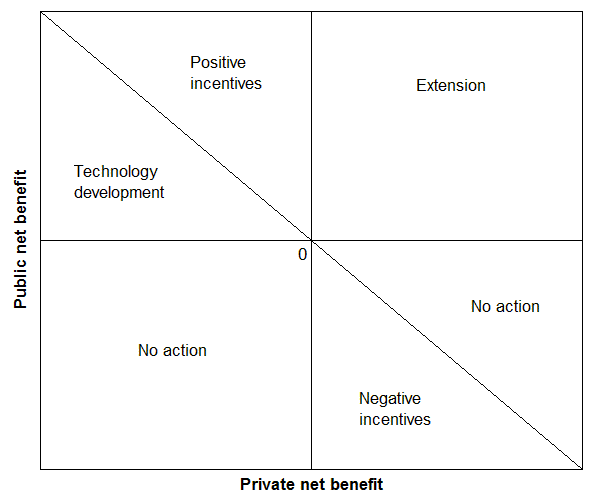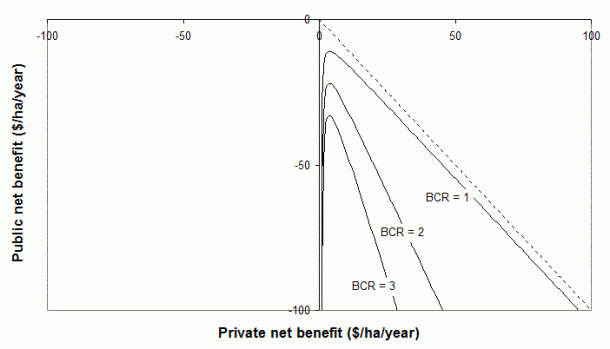78 – Public benefits, private benefits, and negative incentives
This is the fifth instalment of a series that examines a simple framework for choosing environmental policy instruments, as outlined in PD#73. The framework is based on levels of public and private net benefits of changing land management, and a set of simple rules. This time we focus on the use of negative incentives.
In PD#73 I showed how a set of simple and reasonable rules can lead to a map of efficient policy instruments (Figure 1). The context is an environmental manager considering prospective projects to change land use in particular ways on particular pieces of private land. The map shows that the choice of instruments depends crucially on the levels of public and private net benefits from those projects. A particular project to change land use in particular ways on particular pieces of land would be represented by a dot somewhere on Figure 1. Depending on where the various dots lie, different types of policy response are recommended.
In PD#74 and PD#75 we focused on the use of positive incentives and in PD#76 we looked at extension. This time we examine negative incentives more closely.
Figure 1. Efficient policy mechanisms for encouraging land use on private land.
“Negative incentives” means that landholders are encouraged to NOT change their land management in particular ways (e.g. clearing of environmentally valuable vegetation) using tools such as command-and-control regulation, environmental taxes, or, potentially, subsidies as a reward for not changing.
The reasons for recommending negative incentives in the bottom-right triangular area of Figure 1 are (a) projects in that area generate negative public net benefits, (b) they generate positive private net benefits, so landholders are likely to adopt the changed land-use practices unless they are prevented from doing so, and (c) the public net costs outweigh the private net benefits, so there are overall benefits to be gained from preventing the land-use changes that the private landholders would like to adopt.
In previous PDs we have seen that it is possible to refine the set of projects suited to a particular policy mechanism by accounting for further complexities, such as the likely lag to adoption, and the same is true in this case. In PD#75 we presented an illustrative (plausible) relationship between the adoption lag and the level of private net benefits from adoption. The lag to adoption would probably be low if private net benefits are high. As private net benefits fall, the lag (in the absence of incentives) would increase, and it would probably be very long indeed as the benefits of adoption are reduced to zero.
Allowing for this relationship, and assuming that monitoring and enforcement costs the same per ha as assumed for extension (PD#76), the region where negative incentives would pay off shrinks slightly, as shown by the BCR = 1 line in Figure 2. (BCR stands for Benefit:Cost Ratio – if BCR > 1, benefits exceed costs.) The shrinking occurs because, if there is a lag to adoption, the public outcomes are not as significant as they would have been without the lag – other projects with more immediate impacts would tend to rise in the priority list.
Figure 2. Benefit:cost ratios from use of negative incentives, allowing for adoption lags
In almost a mirror image to the result for positive incentives, if we seek to apply negative incentives only in cases where the BCR is higher, it will be in cases where the public net costs are higher and/or the private net benefits are low (see the BCR = 2 and BCR = 3 lines in Figure 2).
The recommendation of “No action” in the right-most triangle of Figure 1 implicitly assumes that we are happy with the current distribution of property rights, whatever that distribution is. For example, if the rights rest with the landholders, they would be free to adopt the new land management practices and reap the available benefits, in the process generating more benefits for themselves than the costs they generate for others. On the other hand, if the rights rest with the public, landholders would need to pay for the right to pollute.
The government could potentially choose to allocate the rights to the public throughout the area where public net benefits are negative, but this would not alter the environmental outcomes compared to “no action”, since landholders would be willing to compensate the public in the right-hand triangle, and landholders were never going to adopt the new practices in the bottom-left area (as private net benefits are negative). It would, however, alter the distribution of wealth, since landholders wishing to implement projects in the right-hand triangle would need to pay some of the resulting benefits to the public.
If the environmental manager is using a change in property rights to generate the negative incentives in the lower triangle (labelled “Negative incentives”), it may be practically difficult or expensive to avoid doing the same thing in the “No action” triangle, and perhaps also in the bottom-left “No action” area as well. If this occurs then, as before, it would not alter the environmental outcomes (e.g. polluters would prefer to compensate pollutees in the right “No action” triangle and continue polluting), but it would alter the distribution of benefits between landholders and the public. It would also involve costs from monitoring and enforcement for a much larger area, which would need to be weighed up when considering the overall merits of the approach.
Property rights approaches, as discussed in the last two paragraphs, are relatively flexible, in that they cause external effects of their actions to be felt by landholders, while leaving the ultimate decisions to them. The landholders can therefore weigh up whether the private net benefits outweigh the public net costs when reaching their management decisions. Mechanisms in this category include tradeable pollution permits, pollution taxes, subsidies and conservation auctions.
If a less flexible mechanism, such as command-and-control regulation, is used across the whole area, there would probably be significant net costs in the right “No action” triangle, as landholders would be prevented from doing things that yield relatively large net benefits to them, and relatively small net costs to the public. Thus we would at least partly (and perhaps fully) offset any net benefits generated in the negative incentives area.
Finally I note that the recommendations in Figure 2 (like all of the recommendations in the framework) depend on the landholders having reasonably accurate perceptions about the private net benefits of adoption. If this is not true, there may be roles for extension, positive incentives or negative incentives in other parts of Figure 1.
David Pannell, The University of Western Australia

